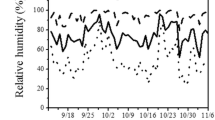Abstract
Sinigrin (allyl glucosinolate), the major glucosinolate in the cotyledons ofBrassica juncea cv. Cutlass, occurred in the highest concentration and amount at seedling emergence and declined during growth. Glucobrassicin (3-indolylmethyl glucosinolate), the major glucosinolate in the cotyledons ofB. napus cv. Westar, occurred in the lowest concentration and amount at seedling emergence. The amount of glucobrassicin per cotyledon pair increased about fourfold during 14 days of growth, but its concentration remained relatively unchanged because of “dilution” by increasing cotyledon biomass. These different glucosinolate profiles indicate a different metabolic control and different biological function for sinigrin and glucobrassicin. The flea beetle,Phyllotreta cruciferae Goeze, does not discriminate between cotyledons having sinigrin or glucobrassicin since the two crucifers were fed upon equally in choice tests. Restricting the concentration of sulfur in the nutrient medium accelerated the decline of sinigrin inB. juncea cv. Cutlass but did not alter the feeding rate ofP. cruciferae compared to controls. Sulfur restriction reduced glucobrassicin inB. napus cv. Westar to undetectable levels and somewhat reduced the feeding rate of P.Cruciferae. Nevertheless,P. cruciferae still fed actively on cotyledons ofB. napus cv. Westar depleted of glucosinolates and severely damaged many of them. Since glucosinolate type and concentration had little effect on feeding response, reduction or elimination of foliar glucosinolates alone would not seem a useful strategy for protecting seedlings of these two crucifers from flea beetle damage.
Similar content being viewed by others

References
Burgess, L., andWiens, J.E. 1980. Dispensing allyl isothiocyanate as an attractant for trapping crucifer-feeding flea beetles.Can. Entomol. 112:93–97.
Dilawari, V.K., andAtwal, A.S. 1987. Effect of cruciferous glucosinolates on probing pattern and feed uptake by mustard aphid,Lipaphis erysimi (Kaltenbach).Proc. Indian Acad. Sci. (Anim. Sci) 96:695–703.
Feeny, P. 1976. Plant apparency and chemical defense.Recent Adv. Phytochem. 10:1–40.
Feeny, P., Paauwe, K.L., andDemong, N.J. 1970. Flea beetles and mustard oils: host plant specificity ofPhyllotreta cruciferae andP. striolata adults (Coleoptera: Chrysomelidae).Ann. Entomol. Soc. Am. 63:832–841.
Hanley, A.B., Heaney, R.K., andFenwick, G.R. 1983. Improved isolation of glucobrassicin and other glucosinolates.J. Sci. Food Agric. 34:869–873.
Hicks, K.L. 1974. Mustard oil glucosides: Feeding stimulants for adult cabbage flea beetles,Phyllotreta cruciferae (Coleoptera: Chrysomelidae).Ann. Entomol. Soc. Am. 67:261–264.
Jonasson, T. 1982. Naringsgnag av jordloppor pa tva varrapssorter med olika glukosinolathalt.Entomol. Tidskr. 103:140–142.
Lamb, R.J. 1988. Susceptibility of low- and high-glucosinolate oilseed rapes to damage by flea beetles,Phyllotreta spp. (Coleoptera: Chrysomelidae).Can. Entomol. 120:195–196.
Lamb, R.J. 1989. Entomology of oilseedBrassica crops.Ann. Rev. Entomol. 34:211–229.
Larsen, L., Nielsen, J.K., Ploger, A., andSorensen, H. 1985. Responses of some beetle species to varieties of oilseed rape and to pure glucosinolates, pp. 230–244,in H. Sorensen (ed.). Advances in the Production and Utilization of Cruciferous Crops. Martinus Nijhoff/Dr. W. Junk Publishers, Dordrecht.
McGregor, D.I. 1985. Determination of glucosinolates inBrassica seed.Eucarpia Cruciferae Newsl. 10(10):132–136.
McGregor, D.I. 1988. Glucosinolate content of developing rapeseed (Brassica napus L. Midas) seedlings.Can. J. Plant Sci. 68:367–380.
Minchinton, I., Sang, J., Burke, D., andTryscott, R.J.W. 1982. Separation of desulphoglucosinolates by reversed-phase high performance liquid chromatorgraphy.J. Chromatogr. 247:141–148.
Nayar, J.K., andThorsteinson, A.J. 1963. Further investigations into the chemical basis of insect-host plant relationships in an oligophagous insect,Plutella maculipennis (Curtis) (Lepidoptera: Plutellidae).Can. J. Zool. 41:923–929.
Nielsen, J.K. 1978. Host plant discrimination within cruciferae: feeding responses of four leaf beetles (Coleoptera: Chrysomelidae) to glucosinolates, cucurbitacins and cardenolides.Entomol. Exp. Appl. 24:41–54.
Palaniswamy, P., andLamb, R.J. 1991. Host plant preference of flea beetles,Phyllotreta striolata (F.) andP. cruciferae (Goeze) (Coleoptera: Chrysomelidae) to crucifer seedlings.Environ. Entomol. In press.
Sang, J.P., andTruscott, R.J.W. 1984. Liquid Chromatographic determination of glucosinolates in rapeseed as desulfoglucosinolates.J. Assoc. Off. Anal. Chem. 67:829–833.
Sang, J.P., Minchinton, I.R., Johnstone, P.K., andTruscott, R.J.W. 1984. Glucosinolate profiles in the seed, root and leaf tissue of cabbage, mustard, rapeseed, radish and swede.Can. J. Plant Sci. 64:77–93.
Thorsteinson, A.J. 1953. The chemotactic responses that determine host specificity in an oligophagous insect (Plutella maculipennis (Curt.) Lepidoptera).Can. J. Zool. 31:52–72.
Verschaeffelt, E. 1911. The cause determining the selection of food in some herbivorous insects.Proc. Acad. Sci. Amsterdam 13:536–542.
Wensler, R.J.D. 1962. Mode of host selection by an aphid.Nature 195:830–831.
Author information
Authors and Affiliations
Rights and permissions
About this article
Cite this article
Bodnaryk, R.P., Palaniswamy, P. Glucosinolate levels in cotyledons of mustard,Brassica juncea L. and rape,B. napus L. do not determine feeding rates of flea beetle,Phyllotreta cruciferae (Goeze). J Chem Ecol 16, 2735–2746 (1990). https://doi.org/10.1007/BF00988082
Received:
Accepted:
Issue Date:
DOI: https://doi.org/10.1007/BF00988082


